How dangerous is sea swimming in cold weather?
- Published
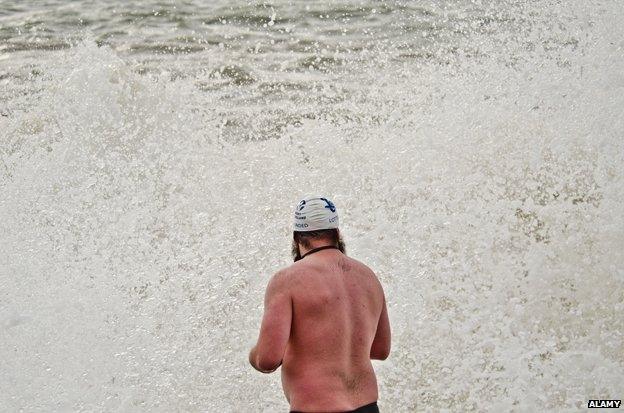
Brighton's historic Christmas Day swim has been cancelled for safety reasons. How dangerous is sea swimming in cold weather?
On Christmas Day 1885 a few hardy souls hobbled across Brighton's pebbly beach and into the chilly English Channel.
That first Brighton Christmas Day swim has become a much-copied ritual around the world. But this year it's been called off. And it seems unlikely the event, which has always been run by the Brighton Swimming Club, will ever be coming back.
Brighton & Hove City Council - supported by the swimming club - says it's become too dangerous. It will close off the beach around the Palace Pier to dissuade people from entering the water on Christmas Day.
"Sea swimming takes skill, stamina and knowledge of the physical dangers and should only be for the very experienced, using suitable wetsuits, in very calm conditions and with a friend," says the council's seafront manager Chris Ingall. The council says it has no plans to bring the swim back in future years.
Marking Christmas and New Year by diving into a cold sea has grown in popularity. Beach swims will be taking place at Southwold in Suffolk, Whitby in North Yorkshire, Porthcawl in south Wales, Prestwick in Ayrshire, Bangor in County Down, and numerous places in Cornwall. Scotland's biggest New Year swim is the Loony Dook in the Firth of Forth. The River Dart in Devon and lakes, such as the Serpentine in London, have festive dips, as do unheated lidos.
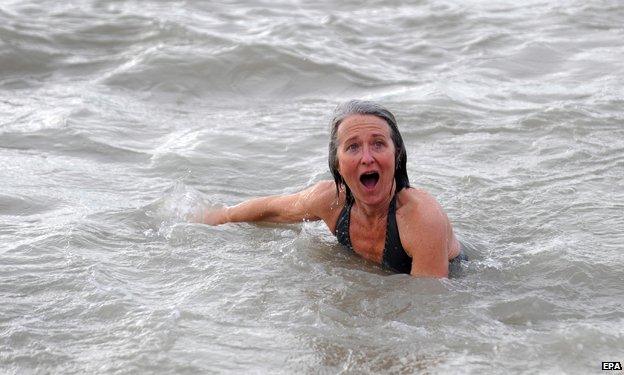
There's a camaraderie to it, says Lynne Roper, a member of the Outdoor Swimming Society who often swims - without a wetsuit - around Burgh Island in Devon on Christmas Eve. And it makes a nice contrast with Christmas excess: "It's the antithesis of being warm and cosy in front of the fire with lots of food. It's almost pagan - leaping into the freezing cold. You get a massive adrenalin rush and it sets you up for the rest of the day." You can then go and hunker down in front of the fire feeling like you've earned it, she says.
It's not just the UK. Dublin Bay has its Forty Foot Swim in the Irish Sea, Barcelona has held the 200m Copa Nadal race since 1907, thousands of Dutch people run into the sea in the traditional Nieuwjaarsduik (New Year's dive) near the Hague. There are many "polar bear plunges" across the US and Canada on 1 January.

Tips for taking the icy plunge
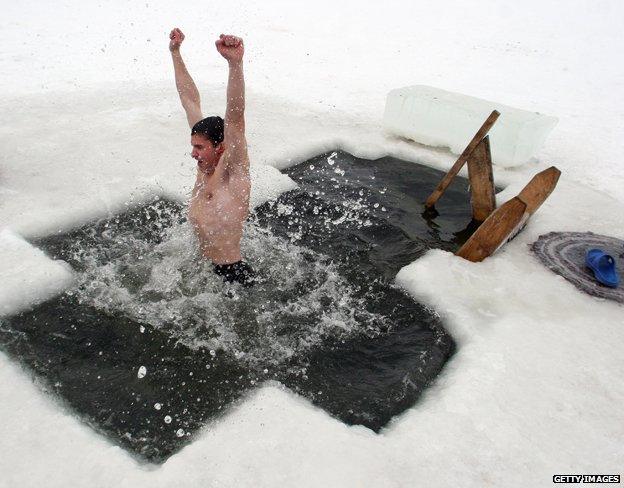
If you're not used to swimming in cold water, the Outdoor Swimming Society, external recommends that you wear a wetsuit for anything more than a quick dip. It also advises that you:
Don't jump into cold water - instead, wade in slowly
Swim close to the shore
Take warm clothes to put on afterwards as, even in summer, you'll feel colder when you get out
Take extra care in reservoirs, which are deeper and colder than lakes and rivers
Shivering and teeth chattering are the first symptoms of hypothermia. If that happens, get out of the water and warm up.
Source: NHS Choices

But how dangerous is swimming in the cold northern hemisphere sea?
In the UK there were 167 coastal drownings last year, according to the RNLI. It was the highest number in four years. More people die at the coast each year than are killed in cycling accidents, the RNLI says. But only a small proportion of these deaths are related to swimming.
The Royal Society for the Prevention of Accidents says that of 93 recreational deaths on beaches and coasts last year, 20 were swimming related, and one was "jumping/diving in". It compares with a total of 59 swimming deaths in all locations, including pools, lakes and rivers. Supporters point out that when set against the millions of swims undertaken in the sea every year, the chance of drowning is extremely low.
The organisers in Brighton feared there would soon be a fatality. A man had to be rescued on Christmas Day 2011 - after the race had already been cancelled due to bad weather. And at Hastings' Christmas Day swim in 2012, a woman drowned after being hit by a huge wave.
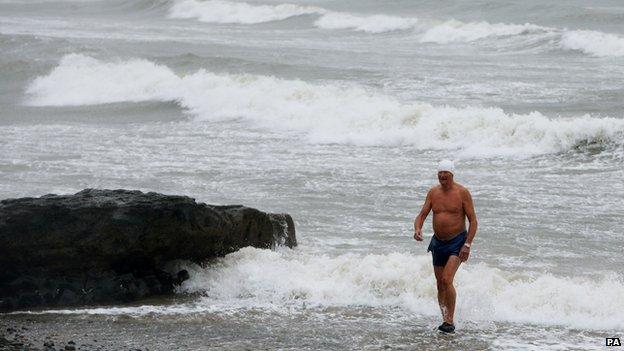
People who swim regularly in the cold develop resilience and can survive in remarkably hostile conditions. The ice mile is becoming increasingly popular - where people swim for up to 40 minutes in water at 5C or less. America's Lynne Cox once swam across the Bering Strait, and the UK's Lewis Pugh swam a kilometre (0.62 miles) at the North Pole. But these were long distance swimmers who not only acclimatised but seem to have had a special propensity for surviving in cold water.
If you're not used to the cold, a common response is to be initially shocked and fight for breath, says Mark Harper, an anaesthetist who swims in the sea off Brighton. It is this struggling for breath that usually causes people to drown, not hypothermia. "Essentially a couple of litres of water in their lungs, that's what kills people. Waves and not being able to hold your breath." It's why sea swimming can be more dangerous than having a dip somewhere like the Serpentine.
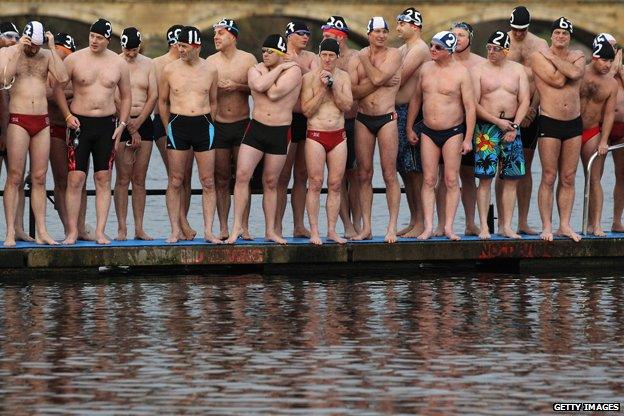
Swimmers prepare to dive into London's Serpentine Lake, Christmas 2011
There may be other groups - people with heart disease or asthma or pregnant women - who may also be better off avoiding cold water. Alcohol worsens your body's ability to regulate temperature, although for a short dip a very small amount shouldn't make too much difference, Harper says. But alcohol does raise the risk of drowning significantly. The US Centers for Disease Control and Prevention says that alcohol is involved in 70% of recreational drownings, external. Most swimming experts advise people not to get into the water after drinking.
In Brighton's case the problem was too many people with little experience of cold water, says Fiona Southwell, sea swimming coach at Brighton Swimming Club.
"What we do at [at the club] is extreme and we're all switched on to that." But once a year swimmers in fancy dress, who may have been drinking or have a hangover, do not understand the risks, she says. "All you need is 15 knot winds and people getting sucked out," she says. "It just got too dangerous and sort of ruined everything."
No activity is completely risk free - there's always a balance to be reached.

A winter dip in the Bristol Channel
Harper, who is a member of Brighton Swimming Club, thinks the cancellation is an "inappropriate response". In the past the council has always waited to see what the conditions are before making a decision. If conditions are calm, as they often are, the risk is small, he says.
And some people are likely to swim with or without official permission, Harper argues. "The sensible thing to do would be to get the lifeboats along and do a charity collection afterwards for (RNLI). Rather than clamp down, you could make it a fun event."
"What a pity," says Matthew Parris of the cancellation. The Times columnist, who in 2010 swam across the Thames in central London, argues there's always going to be risk - the sensible question is how much. And there doesn't seem to have been a spate of swimming deaths at Christmas. There is also a whiff of experts at the swimming club depriving ordinary folk of the pleasures of cold water swimming, he says. "It's a very bad instinct on behalf of clubs to try to bring up the drawbridge behind them and stop amateurs getting involved."
Despite the crackdown in Brighton, swimmers in many places around the world will be diving in this Christmas. Weather permitting, of course.

More from the Magazine
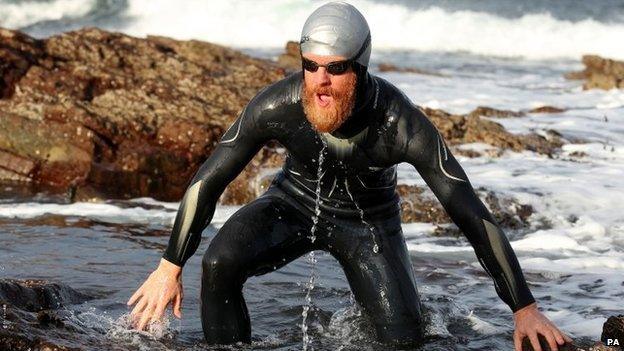
In 2013 Sean Conway finished his four-and-a-half month long swim from Land's End to John O'Groats - via Ireland. But what makes it such a tough challenge?

Subscribe to the BBC News Magazine's email newsletter to get articles sent to your inbox.